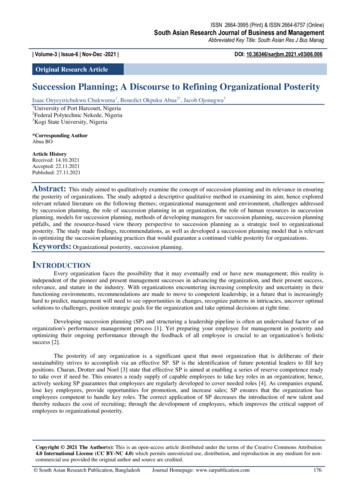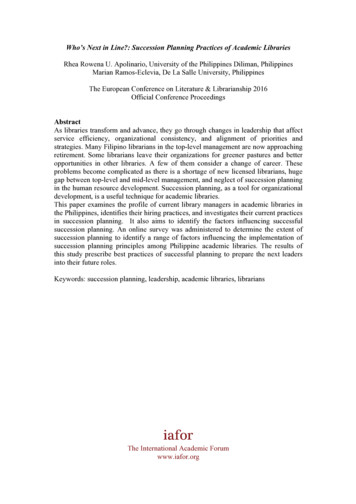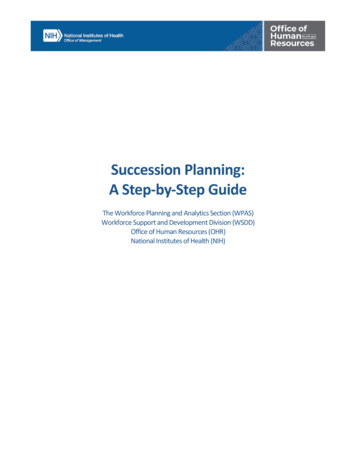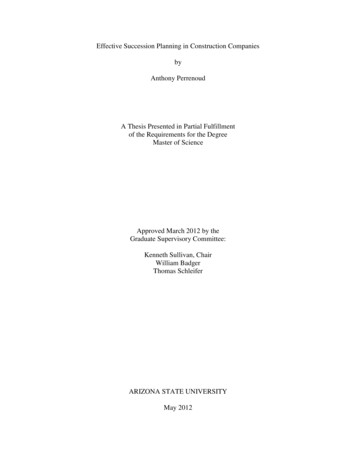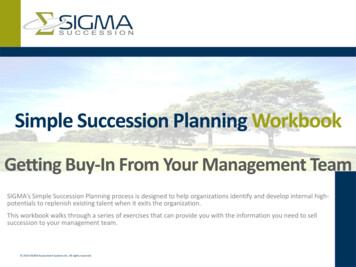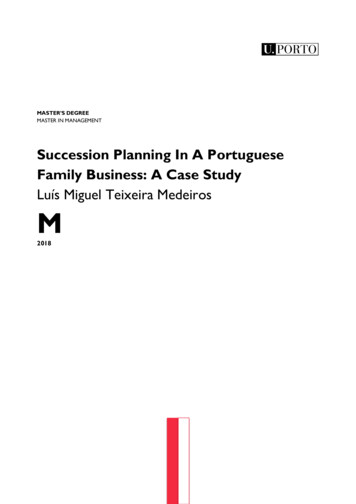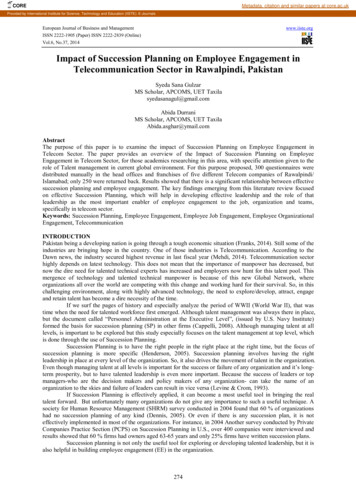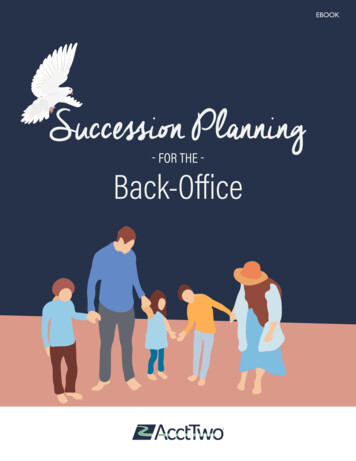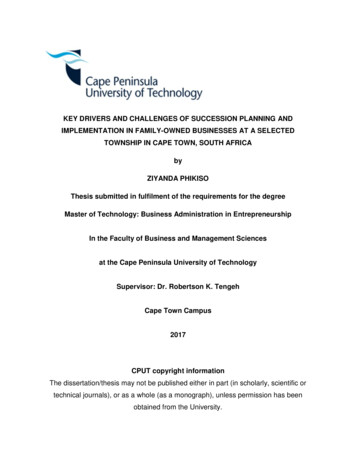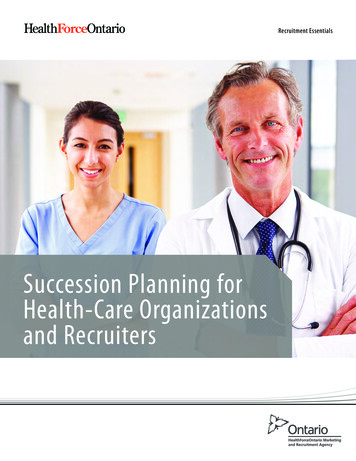
Transcription
Impact of Succession Planning on Employee RetentionMASTER THESIS WITHIN: General ManagementNUMBER OF CREDITS: 15PROGRAMME OF STUDY: Engineering ManagementAUTHOR: Basit Javed & Muhammad JaffarJÖNKÖPING 20 May 2019
Master Thesis in General ManagementTitle:Impact of Succession Planning on Employee RetentionAuthors: Basit Javed & Muhammad JaffarTutor:Tommaso Minola, Ph.D.Date:2019-05-20AbstractThe rise in the employee turnover rates is increasing the concerns amongst the organizationsin retaining the employees in the workplace. The higher turnover rates are threatening the businesscapability in earning higher profits. Grounded by the leadership and motivational theories, thefollowing study aims explore that how the succession planning strategies could help in retaining theemployees in the organization. Swedish organizations are chosen as the area of the study. In order tofulfill the purpose of the research, the data has been gathered from primary and secondary tools. Thesecondary tools used in the study are past papers related to succession planning and employeeretention as well as information collected through SHRM/Globoforce employee recognition surveyand OECD statistical data. The primary tools used in the study are semi-structured questionnaire andface to face interviews. The data analysis involved the evaluation of the secondary data, face to faceinterview and classification of themes on the basis of semi-structured questionnaire. By means of thethematic analysis, four main themes were emerged. The findings showed that in order to retain theemployees fruitfully, Swedish organizations should work on planning career development programs,identify and develop the talent pool and offer non-monetary rewards to the employees. This willenable them to be committed with the company and stay with it for a longer time. The implicationsfor the study is that it will bring a positive social change by adapting the effective successionplanning practices which will as a result help to increase the morale of employee and enhance thebusiness profits by retaining the talented employees in the organization. The study has somelimitations on the basis of which, it is suggested to the future scholars to conduct a quantitative studyby taking a longitudinal approach in order to validate the findings on the statistical grounds as well.Key Terms: Succession Planning, Employee Retention, Leadership, Reward Management, CareerDevelopment1
AcknowledgmentWe would like to express our sincere gratitude to everyone who is involved in completing thisstudy. Firstly, we would like to express our appreciation to our supervisor, Tommaso Minola, who wasproviding us valuable guidance and feedback through the study. Secondly, we would like to thank our peergroup for demonstrating constructive criticism and giving valuable input during the seminars. Thirdly, wewould like to thank all the respondents who participated in the data collection process which eventually led tocomplete our findings.Jönköping International Business SchoolBasit Javed & Muhammad JaffarMay 2019, Jönköping, Sweden2
Table of ContentsAbstract .11.Introduction . 61.1Background. 61.2 Problem Statement .71.3 Significance of the Study . 81.4 Operational Definitions of the Constructs .81.4.1 Talent Management .81.4.2 Career Management .81.4.3 Reward Management . 92.LITERATURE REVIEW .92.1 INTRODUCTION .92.2 Theoretical Foundation of the Study . 92.3 Succession Planning . 102.4 Succession Planning Practices. 102.5 Main Components of Succession Planning . 112.6 Employee Retention. 122.7 Talent Management . 132.8 Career Management . 142.9 Performance Management . 152.10 Training and Development . 162.11 Rewards Management . 162.12 Career Development . 172.13 Employee Recognition . 182.14 Job Promotion Under Maslow‟s Needs Hierarchy Theory . 183
2.15 Purpose of the Study . 192.16 Final Aim of Thesis . 202.17 Research Objectives . 202.18 Research Questions . 202.19 Theoretical Framework . 212.19.1 Explanation . 222.19.1.1 Talent Management . 222.19.1.2 Career Management . 222.19.1.3 Reward Management . 223.Research Methodology. 233.1 Introduction . 233.2 Research Design . 253.2.1 Philosophy . 253.2.2 Approach . 263.2.3 Strategy . 273.2.4 Choices . 273.2.5 Time Horizon . 293.2.6 Data Collection . 293.2.6.1 Questionnaire . 293.2.6.2 Semi-Structured Interviews . 303.2.6.3 Face-to-Face Interviews . 31Interview Questions . 313.2.7 Sample Population and Sampling Method. 313.2.8 Data Analysis and Presentation . 323.2.9 Limitations . 324
3.2.10 Ethical Consideration . 344.Data Analysis . 364.1 Thematic Analysis of Semi-Structured Questionnaire . 364.1.1 Theme One: Meeting Organizational Needs . 364.1.2 Theme Two: Sourcing Strategies for Internal Candidates . 374.1.3 Theme Three: Career Development Leads to Retain Employees . 384.1.4 Theme Four: Non-Monetary Incentives Attracts More . 404.2 Face to Face Interview Analysis . 414.2.1 Interview Questions . 414.2.2 Interpretation . 415. Discussion . 476. Conclusion and Recommendation . 526.1 Conclusion. 526.2 Recommendation in Action. 546.3 Research Implication . 566.4 Implications for Social Change . 566.5 Suggestions for Future Research . 577. References . 595
1. IntroductionThe aim of this chapter is to offer an overview about the topic of thesis.1.1 BackgroundStaff turnover in the business environment which is varying day by day and is gettinghighly competitive is increasing in most of the companies in the world. This results in changingthe demographics of the workers, rise in the global competition and technology that calls for thedevelopment of the talent pool to take the leadership responsibilities and pull the businessestowards the next level. There are some of the managers that feel that there is an issue of highattrition rate which seems to be threatening for the growth of the firms according to Pattanayak(2005). There are about 47% of the companies that are going through shrinking or closing up dueto the absence of competent managers and as a result, there is no one there to encourage theemployees and retain them (Nzuve, 2008). The issue of worker’s turnover also gets costly for thefirms. Apart from recruitment and selection process, the cost linked with making new workersrecords in the human resource department and in making the payroll records and providing thesafety materials while the employee leaves the job is very high that is why it gets expensive forthe companies to bear the turnover cost (Woods, 1997).Succession planning and employee retention besides HR planning are related to staffingand both the terms have a direct impact on eliminating the staff turnover (Ruthwell, 2005). Themajor motive of succession planning is to make sure that there is the presence of preferredmanagers to fill the job vacancies made by promotions, retirement etc. makes sure that a corps ofmanager is present to fill the jobs that might be created in future (Armstrong, 2003).It sometimes takes years to groom the managers; however, a succession plan is presentmainly for the aim to assure the constancy in leadership (John, 2007). Moreover, successionplanning assists the companies in planning for any disasters brought by losses of workersparticularly due to death and early retirements. Incorporating succession planning is linked withthe actual practices conducted in the firm. One fruitful implementation of succession planningenables firms to develop strong leadership and healthy relations to reach organizational goals.6
While employee retention is referred to all the efforts of the management required to make surethat employees do not quit the company (Nzuve, 2010).1.2 Problem StatementSuccession planning implementation is limited in an era of flexible and rapidly changingorganizations where the concept of succession planning has got outdated. Majority of thecompanies give a lot of central focus on the talent management and development processes byforgetting the fact that talented and ambitious workers do not prefer to stay for longer times tosave their management positions (Armstrong, 2012). Presently, most of the firms are notimplementing succession practices that are must to create high potential workers in themanagement position. This results into making the employees struggle to fill the job postespecially at the level of management and they are left dissatisfied among the workers which alsoimpact their performance badly (Eshiteti et al., 2013). The talent war has posed a biggerchallenge for organizations in today's era.There have been a number of studies on the topic of succession planning and employeeretention (Chepkwony 2012). Those researches have however not reported the specific findings;instead, they have observed the mixed findings. Such as Eshiteti et al (2013) investigated theimpact of succession planning on the retention of staff members among the sugar companies inKenya. The study found that the majority of the workers have a higher job contention as therewas proper succession planning done for them by their organization. This showed a positiveimpact on staff retention among sugar firms. Another study investigated the relationship betweentalent management, succession planning and organizational strategy among the commercialbanks (Chepkwony, 2012). It was found that there is a direct impact on talent managementpractices and succession planning.It was also researched by a study where succession strategy and performance of small andmedium companies were investigated (K' Obonvo et al., 2013). The findings showed that there isa significant relationship among succession planning and performance. Thus, no such study wasseen locally that has investigated the impact of succession planning practices on employeeretention in Sweden. The present study, therefore, aims to fill this gap and seeks to answer thecritical research question: how succession planning influences employee retention in Swedishfirms?7
Gap and its RelevanceEmployee retention has been one of the top workforce management challenge highlightedby 47% of the HR leaders in the survey done by Society for Human Resource Management(SHRM)/Globoforce employee recognition report (SIA, 2018). The employee retentionchallenge has been consecutively coming on the top of the list for the last three years. Accordingto the survey done, one of the major challenges that came across was employee turnover andsuccession planning. Given the survey, it can be demonstrated that succession planning needs tobe looked upon by the companies under every industry and the issue needs to be solved as soonas possible.1.3 Significance of the StudyThe study will be significant for the senior managers and higher authority managers as itwill help them to give insights on the fact that how can they make sure that their implementedsuccession planning is geared towards employee retention. Moreover, the study may also beproductive for the government of Sweden to modify their policies that upholds professionalismparticularly at the time of implementing succession planning. Apart from this, scholars andacademic researchers will be benefitted from the study as they will get interesting insights thatcan create a foundation for the future researches. Besides all of this, the study will also benefitthe public and private institutions of Sweden, by creating practical cognizance about effectivemanagement of succession planning in order to enhance the employee retention.1.4 Operational Definitions of the Constructs1.4.1 Talent ManagementTalent management is defined as the unified strategy which is formulated to assist theorganizations in order to make the possible use of human capital in the present time and in futureas well (Lewis & Heckman, 2006). This is done to ensure the maximum return from their talentby offering an attractive organizational culture that motivates happiness and commitment.1.4.2 Career ManagementCareer management is defined as the process that plans and modifies the advancement ofindividuals within the company as per the organizational needs and objectives (Greenhaus et al.,2010).8
1.4.3 Rewards ManagementRewards management is linked with the formulation and incorporation of strategies andpolicies aiming to give rewards to the people in an equal manner and according to theorganizational value. (Armstrong & Murlis, 2007).2. LITERATURE REVIEWThis chapter aims to provide the reader with the frame of reference by explaining theprevious studies and putting light into what previous scholars have to say about the topic.2.1 INTRODUCTIONThis chapter will present the literature review and highlight the theoretical foundation ofthe study by giving a glimpse of the previous studies done on succession planning and employeeretention. The following literature has been reviewed from authentic journal articles, papers, andreports.2.2 Theoretical Foundation of the StudyThe present study will use the leadership theories and motivational theories as thetheoretical foundation to enhance the literature review. This is due to the fact that successionplanning is related to develop the leaders at all levels and motivate the employees whilemanaging the retention of the managers in the organization. Leadership is defined as the processof influencing people to do their best and attain the desired result (Armstrong, 2009).There are a number of leadership theories that have not covered the deeper aspects (Lord& Hall, 2005). From this perspective, emergence theory of leadership development wasrecognized which is based on the experience of ministry leaders over the lifetime. It was alsoexplored by Stadler (2008) that this theory is also applicable to the development of leaders whowork in the business environment as it extends their corporate leadership progress and alsoboosts their executive coaching programs by augmenting succession strategies.On the other hand, motivation theories can be categorized into two different perspectives;one is from the content and the other is process theories. Under this perspective, content theories9
deal with the fact that what motivates the people and what are the individual needs and goals justas proposed by Maslow (Lee & Hanna, 2015), Herzberg and two-factor theory. On the contrary,process theories are related to the process of motivation which is related to the fact that howmotivation will occur as proposed in expectancy theory, goal theory, and equity theory. Apartfrom this, contemporary theory on motivation involves self-worth theory that illustrates thatindividuals should be encouraged primarily by the need to see themselves as competent.2.3 Succession PlanningSuccession planning is defined as a process whereby the companies make sure thatemployees are being recruited and continuously developed to fill the competent key roles in theorganization (Armstrong, 2003). It is also defined as the process of identifying successors for keyposts and planning of career moves further for the probable successors. Hence, careermanagement is corresponding to the management of succession planning (Armstrong, 2012).In a study, succession planning was defined as the process under which companiesrecognize and establish internal individuals with the objective to fill the key job positions withinthe workplace (Casceo, 2006). It is the process where the company makes sure to supply futurekey job successors in order to manage the career of the workers to cater for the organizationalneeds and inspirations (Dessler, 2000). Another study defined the process of succession planningmanagement as the process of evaluating the right talent in the workplace with the objective toseek answers for the three main questions relating to need for potential successor to caterorganizational prolong needs, need for successor’s efficiency and need for the successor’s rightskills and competency for future necessities of the organization (Armstron, 2012). Two types ofsuccession planning were cited in one of the studies including formal and informal successionplans where the previous manager recognizes his own replacement and the company then assessthat individual by means of examining strategic plans and incorporation of promotion fromwithin policy (Baum, 1999).2.4 Succession Planning PracticesAccording to Berthal (1999), succession planning practices involves having a supportsystem with senior management and involving the line managers in recognizing potentialcandidate and integrating the succession management plans with the business strategies (Stadler,2008). In another study, it was identified that succession planning practices must be implemented10
after recognizing the individual needs and then incorporating it (Aswathappa, 2013). Some of themost common practices identified by previous studies under succession planning include selfdevelopment, talent development, diversity management, and job rotation.It has been founded by one of the scholars that seeking for the preferred replacementscomes under the procedure which needs a complex design along with an accurate strategy(Mathur & Agarwal, 2013). It has been further suggested that there must be the three stage modelfor the companies in terms of categorizing their succession planning and development practices.The first phase over here is recognizing the primary roles for the succession and replacementplanning and then identifies the skills and competencies needed to fulfill that role. The secondphase involves the evaluation of people under the criterion. The last stage is addressing the talentpool that will help to fill those roles and establish the employees to get into the advance stage oftheir career. In view of these stages, it has been asserted by other scholars that some otherpractice scan also be adapted in attaining the succession planning that are adequate enough forthe firm (Ramthun & Matkins, 2014). These practices include making the aims clear anddemonstrating the needs of the present performance of the employees.2.5 Main Components of Succession PlanningIt has been claimed by one of the previous researchers that succession planning andmanagement must be linked with the strategic vision and goals of the company. A study hassuggested four main important factors of succession planning (Stadler, 2011). The first factor isaddressing the probable successor. Under this process, a preferred employee is selected on thebasis of skills in order to take the future post of the leader or upper management. This processinvolves recognizing one or multiple employees with whom the company should start itssuccession planning practices. The next component is the rapidly changing management style.The succession planning needs the employees to be taught and managed. The antecedent shouldat the first place forgo the personal management style and act like the teacher while giving thementorship to the employees. The subsequent component is the training and development of thesuccessor. Under this stage, the success of the potential descendant relies on attaining the propertraining and development. The final factor is the act of choosing the successor. At this phasethere are multiple factors to consider while choosing. Among them some of the essential factorsinclude knowledge, skills, competencies and experience of the employee.11
It has been further stated that workers having the higher level of satisfaction in their jobsare usually committed with the company as they have this belief that the company has a goodfuture for them and the company is going to take good care about the contributions done by them(Stadler, 2011). Employees that seemed to be committed with their jobs are more likely to getsuccessful in their jobs and stay in the employment for a longer time. This also raises theirretention possibilities and their productivity. In view of this, another study added that the fruitfulsuccession strategies initiated with the effective practice of hiring. This is due to the fact thatemployees that are competent enough are proven to stay longer in the firm (Singh & Gupta,2015). It was also added that inefficient hiring practices raises the turnover rates in two mainways (Papay & Kraft, 2016). The first one is the new recruiting that is not compatible enoughwill leave the company instantly and the second way is that the staff could turn into becomingfrustrated at a higher level as they feel that a good burden have been placed on theirperformance.2.6 Employee RetentionEmployee retention is the ability of the company to retain its employees and the practicewhich is undertaken by the companies to reduce the turnover rate of the workers (Ramlall, 2004).The four different types of employee turnover include involuntary turnover, voluntary turnover,avoidable and unavoidable turnover. In a study, it was stated that factors of retention arerecognized by the outcome of labor turnover and risk assessment that must be conducted timely.Employee retention requires closer attention to efficiency and equity (Mikovich & Boundreau,1988). It needs a proper definition as per the culture of the organization and its efficientimplementation.It has been noted by the previous scholars that by means of loyalty strategies, thecompanies have the essentially higher employee efficiency and lower employee retention (Liao& Chuang, 2004). The employee retention strategies are taking a rise as being the most importantworkforce organizational challenge in the contemporary world. From the early nineteenthcentury, the previous scholars have been demonstrating not just about the findings based on whythe employees are leaving the organization, but also they have highlighted that how theemployees should be made engaged with the company and in what way they would stay with thecompany. This can be done through the well-implemented employee retention practices that as aresult raise the tenure of employee more as compared to the remuneration for themselves by12
reducing the turnover costs and raising the productivity of employees.The most essential retention strategies are the ones linked with the monetary and nonmonetary rewards. There have been many studies that have focused on the impact of employeecompensation rewards and recognition on the turnover of employees. With regards to salary, astudy has found that the employees that are not paid sufficiently usually end up leaving the job asthis is quite important for them to be paid adequately (Bacon & Hoque, 2005). Along with this,there was another survey done for the employees in the hospitality sector, the study found thatthe annual pay is quiet less among the employees and this was again leading the employees toleave the company (Caraher, 2011). Employees are going to stay in the company as long as theyare satisfied with the pay. Though, many of the studies have identified that compensation highlyimpacts the staff turnover and compensation given in the form of base might not attract the staffor retain them (Rynes et al., 2004).The most essential predictors of retention involve the intrinsic fulfillment and theworking conditions instead of focusing on the financial rewards as noted by the previousscholars. Moreover, the lack of professional growth and development often impacts the turnoverrate rather than creating a balance among the life and work. The past studies based on theconcept of employee retention have explained that employees that are giving the central focus totheir jobs and more towards looking at doing the good add in improving the satisfaction level ofclients in the
Succession planning and employee retention besides HR planning are related to staffing and both the terms have a direct impact on eliminating the staff turnover (Ruthwell, 2005). The major motive of succession planning is to make sure that there is the presence of preferred managers to fill the job vacancies made by promotions, retirement etc .
